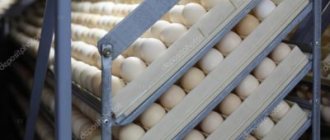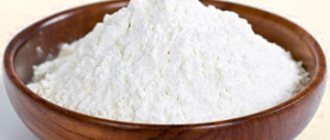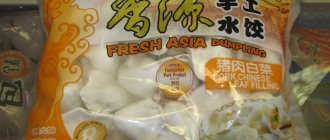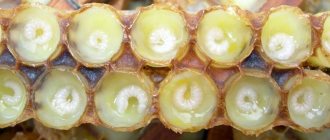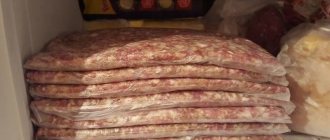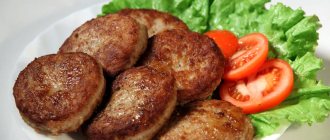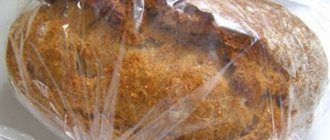Churchkhela is a popular dish of Georgian cuisine. He is known and loved all over the world. Churchkhela is nuts strung on a natural thread. They are poured with thick grape or pomegranate juice on top. The main feature of Georgian sweets is the absence of sugar. Thanks to this, the delicacy has a large number of beneficial properties, and is therefore considered beneficial for the body. But in order for the delicacy to bring benefit and not harm, you need to know how to store churchkhela.
What determines the shelf life?
Hazelnut churchkhela, prepared according to a traditional Georgian recipe, is not a perishable delicacy.
The shelf life of a product depends on several factors , but the key ones are the technology of preparation, drying, and transportation conditions.
When making factory-made churchkhela, manufacturers add a sufficient amount of lactose and nitrates.
Once the treat is ready, it is packed in a vacuum bag, due to which it is stored for a long period of time.
Classic churchkhela is prepared according to a traditional Georgian recipe and packed in paper bags or cloth.
Classic sweets are not stored as long as factory-made ones, and the shelf life depends on how correctly the production technology was followed.
Correct transportation
This product should be transported in a cooler bag. If you place it in a paper bag or a closed ceramic container, it will not deteriorate within 40 - 60 days. Those. during the entire permissible storage period.
If you are planning a long move, then:
- the sweetness is pre-dried well,
- then wrapped in dry natural fabric,
- after which it is placed in a clay vessel.
In this form, nothing will happen to her for 30 days. Even without a cooler bag.
If the temperature inside the container does not exceed +20°С -+22°С, churchkhela can move in it over a long distance without loss of quality.
But it is strictly forbidden to transport this product in a plastic bag.
What is included in churchkhela?
The components that the factory manufacturer uses in the process of preparing churchkhela are indicated on the vacuum packaging.
When making this classic delicacy, the use of preservatives, sucrose and starch is avoided.
The constant ingredients of the Georgian dessert include:
- ground Voloshsky and almond nuts, hazel,
- cherry, apple, grape or apricot nectar,
- wheat or corn flour.
Important! Eating churchkhela in large portions is strictly prohibited. Georgian sweets contain high-calorie components.
Kernels obtained from fresh walnuts are strung on a white thread, and the fruit juice is boiled and thickened with corn flour.
The thread with strung kernels is dipped into the resulting mixture and then dried for 2 hours. If necessary, churchkhela is soaked in nectar again, then hung in a secluded place and left for 7-14 days.
Be sure to read:
The main condition for storing yeast dough is to ensure that the baked goods are soft and fragrant.
To keep the treat for a long time, it is packed in a piece of fabric or cardboard packaging. The room where the sweets are stored must be free of moisture: this can cause the taste of the product to deteriorate.
Plum churchkhela
- walnuts – 0.5 kg;
- plum (peeled) – 0.5 kg;
- flour – 0.3 kg;
- sugar – 0.2 kg;
- water – 0.8 l;
- cardamom – 5 g;
- cinnamon – 5 g;
- cloves – 5 g.
Cooking method:
- Break the nut kernels into 2–4 pieces and string them onto threads. The length of the ligaments should be 18–20 cm.
- Heat half a liter of water to about 30 degrees. Gradually add flour, whisking the liquid. It is important to prevent lumps from forming. If this cannot be avoided, strain the flour mixture through a sieve.
- Place the washed, dried and pitted plums in a blender bowl and grind until pureed.
- Dilute the plum puree with the remaining water. Add sugar and spices, stir. Bring to a boil over low heat until the sugar dissolves. Cook for some more time, stirring, until the plum mass has reduced by 30–50 percent.
- Add the flour mixture little by little. The result should be a homogeneous mass, the consistency of thick jelly.
- One by one, dip all the threads with nuts into the prepared plum mixture. Let them dry slightly. Repeat the procedure 2-3 more times. As a result, all nuts should be covered with a thick layer of plum mass.
- Hang the nut threads covered with plum puree from the loops and leave to dry for at least 7 days.
Churchkhela prepared according to this recipe has an appetizing color, sweet and sour taste and is not inferior in its organoleptic qualities to traditional grape churchkhela.
Churchkhela is a healthy dessert belonging to Georgian cuisine, although it is also made in a number of other countries. The main ingredients are nuts and condensed juice. Usually in Georgia, walnuts and grape juice are used for churchkhela, but in central Russia, it is advisable to use apple or plum juice, which are more accessible here, to prepare the sweets.
Everyone has tried sweet churchkhela. This wonderful oriental dessert is not only tasty, but also healthy, and since its shelf life is about six months, you can stock up on it for future use. And you don’t have to buy it! I want to tell you how to make this sweet with your own hands. Believe me, churchkhela at home is not difficult.
The recipe for the oldest delicacy, which in Armenia is called fruit sujukh, and in Georgia - churchkhela, is carefully passed down from generation to generation. Since this is a rather labor-intensive process, you need to be patient. Almost every region of Armenia and Georgia has its own variety of fruit sujukh or churchkhela. They may differ significantly in the set of ingredients, but the cooking technology is basically the same.
This recipe with walnuts and grape juice can be used as a basis to understand the principle. In general, there are so many cooking options that the concept of “real” simply does not exist.
How to choose fresh?
In order to store churchkhela for a long time, you need to follow the recommendations for its correct selection:
- It is strictly forbidden to buy churchkhela, on the top layer of which there are grains of sugar. This suggests that the cooking technology was not followed during its preparation.
- If the top layer of the treat is dotted with cracks, you should refrain from purchasing it. This indicates that excessive amounts of flour and sugar were used in its production.
- In order to make sure that the treat is not “rubbery” , when purchasing it, it is recommended to bend the protruding thread.
The best option is to purchase freshly prepared churchkhela and dry it yourself.
A finished, high-quality product must have a soft interior and a dried out crust.
Common Mistakes
Even if the technology for drying the product is followed, the oriental delicacy may dry out prematurely. What to do with the product to return it to its original appearance?
To return the product to its original appearance, it is recommended:
- put it in water;
- hold over steam;
- wrap in plastic and microwave for a couple of seconds.
Any of the resuscitation methods is available and effective, but it is no longer possible to store the updated product. Sometimes it is not possible to soften the product because there is too little liquid left in the treat.
How to properly store at home?
Damage to churchkhela in most cases can be caused by the formation of mold.
The nutrient mass of flour and fruit juice promotes the rapid development of microorganisms, especially if a warm and humid room was chosen to store the sweets.
To successfully preserve oriental delicacies, it is important to comply with the following conditions:
- a little ventilation in the room and dry air,
- the room temperature should fluctuate between +15…+20 degrees.
You need to store sweets at home in rooms with good ventilation.
Churchkhela must be wrapped in breathable gauze or thin paper that absorbs moisture and protects the product from dust and pests.
Can it be kept in the refrigerator?
In ancient times, churchkhelas were not stored using additional cooling. But with the advent of refrigeration units, many people wondered whether it was possible to store delicacies in the refrigerator.
Be sure to read:
Quail eggs: terms and storage conditions
This is not a prerequisite, but if you wish, you can keep the product in the refrigerator.
Storing churchkhela in the refrigerator can prevent the formation of mold, but at the same time it increases the risk that the delicacy will dry out faster.
The product should be wrapped in a piece of gauze or thin paper and then placed in the refrigerator. It is strictly forbidden to freeze freshly prepared sweets.
How long does it last at room temperature?
If suitable conditions have been created for storing the oriental delicacy, the product can last for quite a long time. The drying of the crust can only be noticed after 30 days: then it will be difficult to chew the churchkhela.
In order to soften a dried treat, you need to place it next to flour products (loaf or bun). Baked goods will soften the sweetness.
Methods for softening hardened crust
What to do if the churchkhela has already dried out a little? There are several ways to restore its softness, but only if the product has not been spoiled, otherwise digestive problems may arise.
You can soften the dried sweetness by placing it in a sealed container next to fresh bread, and then the churchkhela can become a little softer, absorbing the moisture evaporated by the baked goods.
Or hold the hardened treat over steam and then consume immediately. You can also use the microwave to warm up the juice crust for a short time.
How can you tell if it has gone bad?
It is quite easy to determine that churchkhela has become unfit for consumption . This can be understood by the consistency of the product and its appearance.
A spoiled treat may contain mold, which is not always visible on the surface. Before you eat churchkhela, you need to break it and carefully examine it for the presence of fungus.
If the product has a wet surface, a softened crust that is falling apart into pieces, you should stop using it. This indicates that the storage conditions were violated or the production technology was not followed.
Almond
Most often, peeled almonds are eaten, since the nut in the husk has a bitter taste. It is recommended to store peeled almonds at home that have not been subjected to heat treatment.
In summer, place nuts in a cool room or in the refrigerator. In winter in an insulated balcony. Keep the product away from direct sunlight. For packaging, choose a glass jar with a tight lid; plastic containers with a vacuum effect are also suitable.
Storing several types of nuts in one container is strictly prohibited. Extraneous proximity harms the taste of almonds. At room temperature or in a plastic bag, the product will soon become bitter.
In a cold room, the shelf life reaches six months. When frozen, almonds retain their beneficial and flavorful properties throughout the year.
Almonds in the shell last longer. Therefore, if long-term storage is intended, buy a nut in the shell. Storage recommendations:
- Humidity no more than 75%.
- The air temperature in the room is no more than 18 degrees. High temperatures threaten the rapid formation of mold and the bitter taste of the kernels. The lower the temperature, the longer the almonds are edible.
- Select containers taking into account the need of almonds for fresh air.
- The room must be darkened.
Almonds in such conditions will be useful until the next harvest.
Signs of product spoilage
If the conditions are incorrect or the storage period has expired, the dessert may spoil. Signs of damage:
- the appearance of mold - a white layer on top of the treat;
- the dessert does not hold its shape and quickly falls apart;
- the surface of the treat has become wet and sticky;
- unpleasant bitter taste and smell.
When purchasing a Georgian national delicacy, be sure to look at the production date. If it is not there, then you need to find out from the seller when the sweetness was produced. If the product looks dubious, and the seller finds it difficult to answer the question about the exact production date, then it is better not to buy churchkhela from him.
